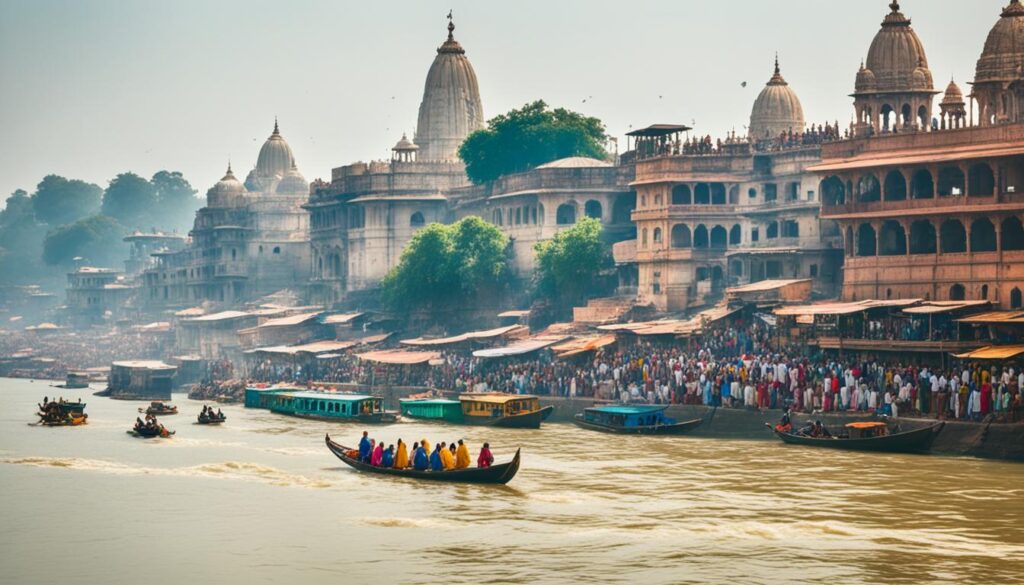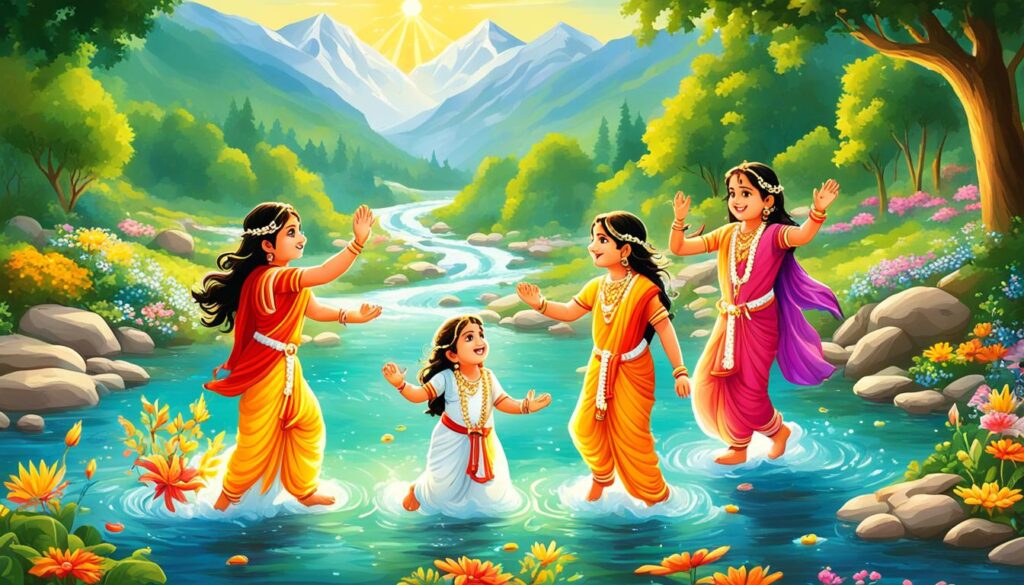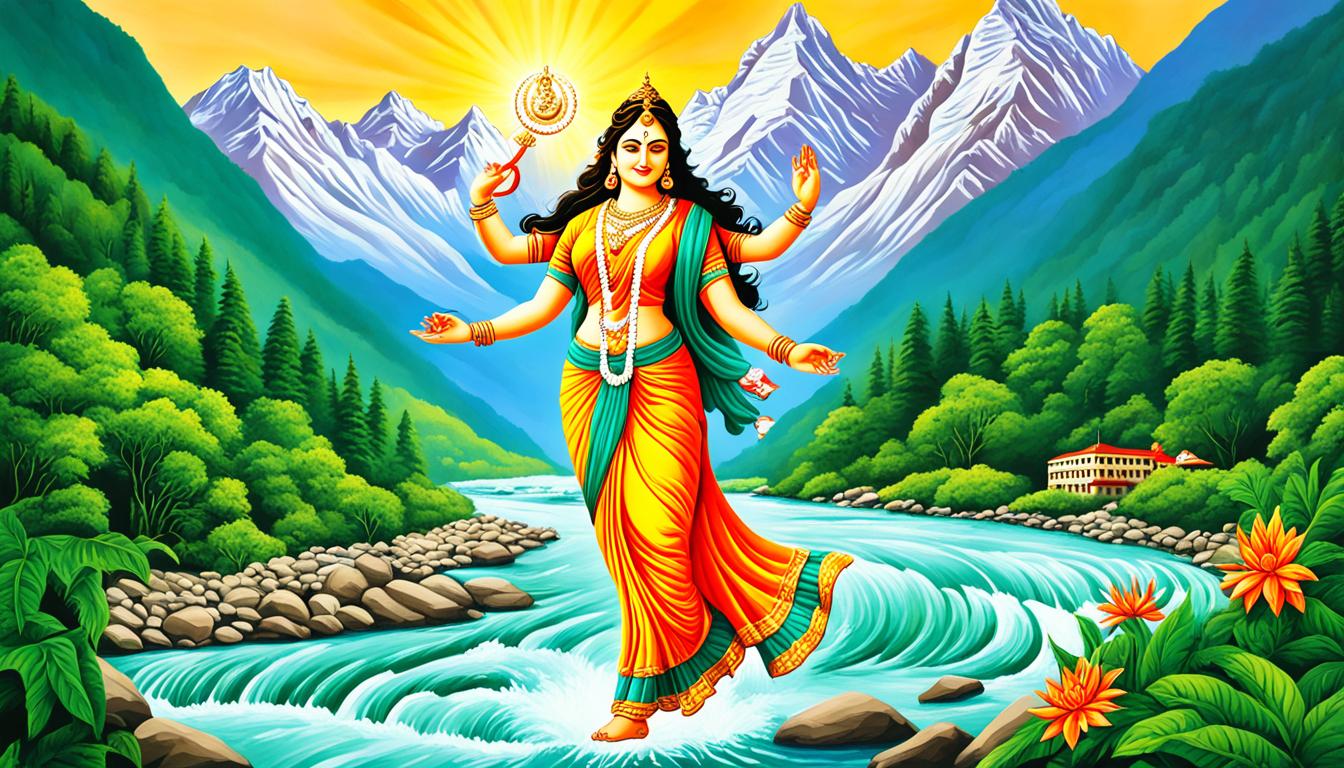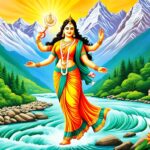The Ganga, or Ganges River, has captured the hearts of millions. It starts in the majestic Himalayas and flows through the Indian subcontinent. Known for much more than being a river, it symbolizes India’s deep spirituality and culture.1 This river is crucial, providing water to 40% of India’s people.1 Its basin also plays a big role in India and Bangladesh’s agriculture.1 To many, though, the Ganga is like a mother goddess, called Ganga Mata.
Hindus have many names for the Ganga, such as Jahnavi and Gange.2 They believe it flows from and connects Heaven, Earth, and the Underworld, showing its divine nature.2 In ancient Sanskrit, a person who visited these places is called Tripathaga.1 Its spiritual importance is why Hindus see it as the goddess Ganga, or Ganga Mata.
Key Takeaways
- The Ganga River is the largest river in India and provides water to 40% of the country’s population.
- The Ganga Basin has fertile soil that significantly influences the agricultural economies of India and Bangladesh.
- The Ganga is revered as the embodiment of the divine, personified as the Goddess Ganga or Ganga Mata in Hinduism.
- Hindus believe that bathing in the Ganga can cleanse all sins and help attain moksha (salvation).
- The Ganga is known by various names, including Jahnavi, Gange, Shubhra, and Bhagirathi, among others.
The Origins of the Ganga River
Bhagiratha, a king, knew only Ganga could free his ancestors. They were cursed and needed her to find Nirvana. He did severe penance for years to bring her to Earth.2 Finally, River Ganga came down, and Lord Shiva led her path. From his hair, she flowed to Earth. This spot is now called Gangotri, and it is also named Jatashankari because of Shiva’s jata (hair).2
The Story of King Bhagiratha
Ganga flooded sage Jahna’s ashram, and he halted her out of rage. On Bhagirath’s request, the sage let her go again. That’s why Ganga is also known as Jahnavi.2 She then cleansed Bhagirath’s ancestors in sage Kapil’s ashram, allowing them peace.2
The Descent of Ganga from the Heavens
Bhagiratha worked hard to purify King Sagara’s sons and earned their release. Brahma permitted Ganga to fall, and Shiva softened her landing with his hair.2 Thanks to Bhagiratha, Ganga carries the names Bhhagirathi and Tripathaga, symbolizing heaven, earth, and the underworld.2
The Names and Forms of Ganga
Ganga is Jahnavi too. This name comes from a tale of Sage Jahnu drinking her and then letting her out through his ear.2 In the Mahabharata, Ganga is Queen Shantanu’s wife and Bhishma’s mother.2
| Ganga River Statistics | Values |
|---|---|
| Length | 2,525 km (1,569 mi)3 |
| Basin Size | 1,999,000 km2 (772,000 sq mi)3 |
| Average Discharge at Mouth | 38,129 m3/s (1,346,500 cu ft/s) to 43,900 m3/s (1,550,000 cu ft/s)3 |
| Average Discharge at Farakka Barrage | 16,648 m3/s (587,900 cu ft/s), with a minimum of 180 m3/s (6,400 cu ft/s) and a maximum of 70,000 m3/s (2,500,000 cu ft/s)3 |
| Aquatic Biodiversity | Home to approximately 140 species of fish, 90 species of amphibians, and various other types of reptiles and mammals3 |
Ganga Mata: The Hindu Goddess
In Hinduism, the Ganga River is seen as the Goddess Ganga. She stands on a crocodile mount, the makara. In her hand, she holds a kumbha, a pot of water, while an attendant shelters her with a parasol.4 Her divine mount is a Makara, it has a crocodile’s head and a dolphin’s tail. She typically has either two or four arms. She may carry water lilies, a water pot, or a mala (rosary).4
Iconography of the Goddess Ganga
In Ahichatra, Uttar Pradesh, a 5th-century terracotta figure of the goddess Ganga exists. It is now in the National Museum, New Delhi.4 She’s shown as a fair woman, seated on a crocodile. She holds a water lily and a flute.2
The Purifying Powers of Ganga
Hindus believe that bathing in the holy Ganga can cleanse people of their sins.5 They also think that touching the river helps one achieve salvation. Because of this, they put the ashes of the dead in the river.52
Ganga is revered as a goddess from the Himalayas to the Bay of Bengal. She’s important in Hinduism for cleansing sins. Hindus believe that taking a dip in the river can purify the soul and lead to salvation (Moksha).4
The Religious Significance of Ganga
In Hinduism, the Ganga River is seen as the Goddess Ganga.6 Hindus believe it’s the holiest river in India, mentioned in sacred texts.4 They see the Ganges as a goddess who purifies sins with her water.4 Vishnu, a Hindu God, said, “Just seeing the Ganges can wash away thousands of sins.”4
Ganga: The Embodiment of Vishnu
4 Hindus view the Ganges as filled with divine powers. Many gods, including Shiva, Vishnu, and Brahma, have close ties to the river.6 They worship Ganga as a goddess of purity and deep spiritual meaning.
Rituals and Blessings Associated with Ganga
4 The river’s water is considered purifying by Hindus. They think performing rituals on its banks or in its water brings good luck and cleanses sins.6 Hindus use Ganga water for purifying rituals. Bathing in the river is believed to wash sins away.4 The Ganges River is essential in Hinduism for removing sins, even the most serious ones.6 Along the river, many holy places like Allahabad and Varanasi attract pilgrims.
Ganga: The Lifeline of India

The1 Ganges River is India’s biggest, serving 40% of its people. It nurtures fertile land, enriching India and Bangladesh.1 This river is vital for farming and fishing, supporting many livelihoods.1
The Fertile Ganges Basin
The7 Ganges River runs 1,560 miles, shorter than some Asian rivers. Yet, it influences a quarter of India, helping millions.7 It’s a major water source, with the Ganges providing a big share.7
The Importance of Ganga for Agriculture and Fishing
The3 Ganges river, 1,569 miles long, feeds a vast basin.3 It’s crucial for farming, serving as a major irrigation source. This benefits India and Bangladesh greatly.1 The river also powers fishing, supporting local economies.1
Ganga Mata: Religious Tourism
The Ganga River is a key spot for those seeking spiritual adventures in India. It draws devotees and tourists to its holy shores.2 Cities like Varanasi, Haridwar, and Allahabad have strong religious significance for Hindus.2
Sacred Cities on the Banks of Ganga
Places like Haridwar and Allahabad are incredibly sacred in Hinduism. They are well known for the esteemed Kumbh Mela gatherings.2 Haridwar is even called the “Gateway to heaven,” marking a special spiritual place.2
The Kumbh Mela and Haridwar
The Kumbh Mela is a huge deal, gathering millions during special times. These events happen in cities like Allahabad and Haridwar. People come to cleanse their spirits in the Ganga’s waters and seek blessings.2 Haridwar fascinates with its deeply spiritual essence and vibrant life.
| City | Significance |
|---|---|
| Varanasi | One of the oldest living cities in the world, known as the spiritual capital of India and a prime ganga cities destination. |
| Haridwar | Considered the “Gateway to Heaven”, Haridwar is a major kumbh mela host city and a hub for ganga mata religious tourism. |
| Gangotri | The source of the Ganga river, Gangotri is a popular pilgrimage site for Hindu devotees. |
| Allahabad | Also known as Prayagraj, Allahabad is a major kumbh mela host city and an important destination for ganga mata religious tourism. |
| Rishikesh | Rishikesh is a hub for yoga, meditation, and spiritual retreats along the banks of the Ganga. |
The Spiritual Traditions of Ganga
The famous Ganga Aarti happens at dusk every day. It’s a powerful ceremony to witness.4 The air is sweet with the scent of flowers and incense. Many priests take part, moving lamps while singing hymns.
The Ganga Aarti Ceremony
The Ganges river is holiest in Hindu scriptures.5 It’s a peaceful place for yoga and meditation. Rishikesh, known for Hatha Yoga, hosts many ashrams by the Ganga.
These places are great for those seeking inner calm.
Yoga and Meditation Retreats
The Ganga bathing ghats are famous and draw many visitors.4 They are steps leading into the river. Hindus believe its water can purify them from sin.4
The Ghats of Ganga
Adventure and Exploration on Ganga
The Ganga has become a top spot for adventure in Rishikesh. The emerald waters are perfect for activities like river rafting and kayaking.1 The river’s fast flow creates fun challenges for thrill-seekers, especially in the epic rapids. You can also take it slow on a boat, enjoying the scenery and learning about Indian culture.
River Rafting and Water Sports
Rishikesh on the Ganga’s banks is a hotspot for adventure.1 River rafting here is thrilling, letting you conquer the river’s rapids. For a different experience, try kayaking or body surfing. They let you feel the Ganga’s currents up close.1
Boat Rides and Scenic Cruises
If you prefer a calm Ganga experience, try a slow boat. You can enjoy the stunning views and see local traditions. From the boat, watch the1 Ganga Aarti ceremony, a beautiful daily ritual. You’ll also see the famous1 Ganga ghats, used for bathing and ceremonies.1
Ganga Mata: The Divine Children

In the Skanda Purana, it says that the goddess Ganga is like a mother to Kartikeya. He’s also called Kartika, Subrahmanya, Murugan, and was the son of Shiva and Parvati.8 The Shiva Purana adds that Lord Shiva’s son was meant to help the Earth. He led the Devatas to get rid of the Asuras who were causing trouble.8
Kartikeya: The Foster Son of Ganga
Parvati once made a Ganesha out of her own holy dirt. She brought him to life by putting him in the Ganges.8 That’s why Ganesha is known to have two moms, Parvati and Ganga. This makes him special and he’s called Dvaimatura and Gangeya.8
Ganesha: The Son of Parvati and Ganga
The Mahabharata story talks about the Vasus being cursed and then asking Ganga to be their mom. Ganga agreed but had a rule for her husband, King Shantanu. She said he couldn’t question her decisions.8 Together, they had a son named Bhishma. In the Mahabharata, Bhishma is a very honored figure.8
Bhishma: The Son of King Shantanu and Ganga
Conclusion
The Ganga is more than just a river. It is the lifeblood of the Hindu tradition. It represents divinity, holy scriptures, and enlightenment. Its worship is deep and direct without needing special rituals. This connection lasts forever as long as the river flows.
The Nile reflects Egyptian culture, Huang He symbolizes China, and the Ganges is at the core of Indian civilization. It serves as India’s lifeline, nourishing its people and those living in Nepal and Bangladesh. The Ganga isn’t just about water and fertility. Its spiritual value lies in being the embodiment of Hindu faith, myths, and traditions.
The story around Radhanath Swami’s experiences and beliefs about the Ganges raises questions.9 Yet, the river is central to Hindu culture. It’s revered as a goddess and praised in the Rig Veda.10 The tale of the Ganges descending from heaven is a powerful and old Indian myth.10
Finally, the Ganga represents the heart and soul of India’s spiritual history. It provides life to its people and is key to the nation’s identity. As long as the Ganga flows, it will remain not just a river but a symbol of India’s faith and culture for all time.
FAQ
What are the names by which the Ganges River is known?
The Ganges River has many names, such as Jahnavi, Gange, and Shubhra. It is also known as Sapteshwari, Nikita, and Bhagirathi. Other names include Alaknanda and Vishnupadi.
What is the religious significance of the Ganges River?
For Hindus, the Ganges River is sacred and is like a goddess, Ganga. It’s thought that bathing in it can cleanse away wrongdoings. People also put the ashes of their loved ones into the river.
How did the Ganges River come to Earth?
According to Hindu tales, King Bhagiratha brought the Ganges to Earth. He did a lot of penance to persuade the goddess Ganga to come down. Finally, Lord Shiva helped, letting the river flow through his hair.
How is the Goddess Ganga depicted in Hindu iconography?
Goddess Ganga is often shown standing on a mythical creature called a makara. She carries a pot of water and has someone with her holding a parasol. Sometimes she’s shown with four arms, holding things like flowers or a water pot.
What are the purifying powers of the Ganges River?
Hindus believe the Ganges can clean sins. Even a touch is thought to help reach moksha, or salvation. People also believe its water can purify them and bring good luck.
What is the importance of the Ganges River for India?
The Ganges is vital for India, providing water to 40% of its people. It supports farming and fishing. The soil along the river is very fertile, adding to India and Bangladesh’s agricultural benefits.
What are the major cities and religious sites along the Ganges River?
Varanasi, Haridwar, Gangotri, and Allahabad are among the cities. Rishikesh is there too. These places are holy for Hindus and popular for visits.
What are the spiritual traditions and practices associated with the Ganges River?
The Ganga Aarti is a notable practice, with priests lighting lamps and singing. Many come for yoga and meditation. Bathing in the river at the ghats is seen as lucky.
What are the adventure and exploration activities available on the Ganges River?
The river offers adventure like rafting, kayaking, and body surfing in Rishikesh. There are also calm boat rides. These let people view the beautiful scenes and local life.
What is the significance of the Ganges River in Hindu mythology?
In Hindu myths, the Ganges is seen as a mother to deities like Kartikeya and Ganesha. It’s linked to tales like that of King Shantanu and his respected son Bhishma from the Mahabharata epic.
Source Links
- https://www.sodhatravel.com/blog/the-story-and-significance-of-river-ganga
- https://en.wikipedia.org/wiki/Ganga_(goddess)
- https://en.wikipedia.org/wiki/Ganges
- https://earthstoriez.com/india-mythology-mother-ganga-or-the-ganges-river
- https://kathleenkarlsen.com/ganga-mata-mantra/
- https://www.exoticindiaart.com/article/goddess-ganga-waters-of-devotion/
- https://www.britannica.com/place/Ganges-River
- https://goddessgift.com/goddesses/ganga/
- https://prabhupadavision.com/2011/03/02/ganga-sampradaya/
- https://www.exoticindiaart.com/article/ganga/

